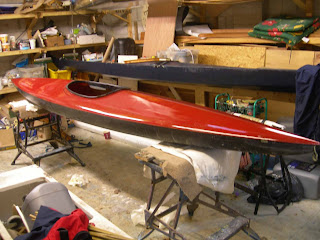Finishing the frame
Lashing the chine stringers
Grooves can be cut in the chine stringers to take the twine as any bump that ends up on the surface is much less likely to wear through as it is the keel that takes all of the wear from groundings etc.
The next two pictures shows the stringer being lashed to the frame. In the plywood frames such as this one the needle and thread is taken through one small hole. The second photo shows how the thread is secured through a series of half hitches. You can also see how I have rounded the stringer. This is to save a bit of weight and more importantly present a smooth surface fro the fabric to pull over.
I find it convenient to start the lashing of all the stringers from the stern and work forward.
This done the boat is turned over and the foredeck stringer pinned in place using the barbecue skewer pins again. The stringer is thickest near the cockpit to provide sufficient strength should a boat need to be hauled over the deck in a rescue.
Similar principles apply to the stern deck stringers which also need to support the weight of the paddler behind the cockpit.
Then the seat goes in being lashed to the two central frames, positioned to take the ends of the seat slats, they are rounded off before being lashed and sewn in place as shown in the next three photographs.
The frame is shown awaiting adjustment of the masik, which needs to move back in line with the end of the bow deck stringer, and the footrest.
Grooves can be cut in the chine stringers to take the twine as any bump that ends up on the surface is much less likely to wear through as it is the keel that takes all of the wear from groundings etc.
The next two pictures shows the stringer being lashed to the frame. In the plywood frames such as this one the needle and thread is taken through one small hole. The second photo shows how the thread is secured through a series of half hitches. You can also see how I have rounded the stringer. This is to save a bit of weight and more importantly present a smooth surface fro the fabric to pull over.
I find it convenient to start the lashing of all the stringers from the stern and work forward.
This done the boat is turned over and the foredeck stringer pinned in place using the barbecue skewer pins again. The stringer is thickest near the cockpit to provide sufficient strength should a boat need to be hauled over the deck in a rescue.
Similar principles apply to the stern deck stringers which also need to support the weight of the paddler behind the cockpit.
Then the seat goes in being lashed to the two central frames, positioned to take the ends of the seat slats, they are rounded off before being lashed and sewn in place as shown in the next three photographs.
The frame is shown awaiting adjustment of the masik, which needs to move back in line with the end of the bow deck stringer, and the footrest.










Comments
Post a Comment